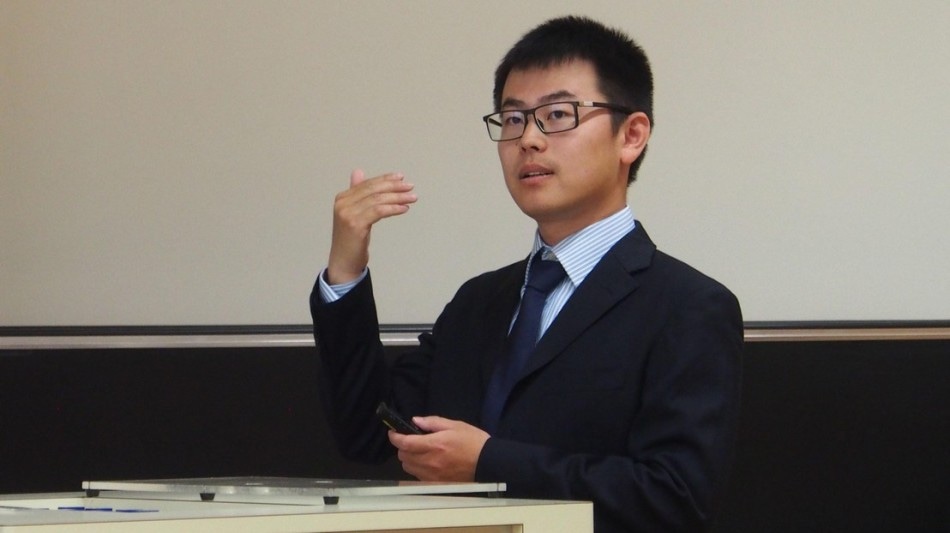May 15 2019
Adequate daylight exposure adds to occupants' productivity, well-being, and health in buildings. However, too much sunlight ingress induces discomfort glare and raises the cooling load in the warm season. The performance of manual shading systems is restricted by the users’ low interaction frequency. Since sky conditions are dynamic, recurrent blinds alterations are required, but these are impractical for users to cope with.
 Dr. Yujie Wu successfully defended his thesis on Friday, May 3rd. He outlined the concept of an independent, decentralized system with a built-in photometric device to automatically manage the blinds position in buildings. A new step towards the Energy Transition 2050 and living and/or working spaces with low carbon emission. (Image credit: © 2019 EPFL)
Dr. Yujie Wu successfully defended his thesis on Friday, May 3rd. He outlined the concept of an independent, decentralized system with a built-in photometric device to automatically manage the blinds position in buildings. A new step towards the Energy Transition 2050 and living and/or working spaces with low carbon emission. (Image credit: © 2019 EPFL)
Numerous shading automation systems have been suggested to nurture the utilization of daylight in buildings, the performance of which is restricted by several factors, including unsatisfactory glare protection, privacy issues, disturbing movement of slats, and commissioning difficulty. In this doctoral thesis, an incorporated daylighting control system is recommended and demonstrated to control daylight in buildings. According to real-time lighting computations based on the monitored luminance distribution of the landscape and sky, the projected system is fully decentralized.
First, an embedded photometric device (EPD) was designed and corroborated; exhibiting enhanced accuracy in daylighting simulations compared to using regular sky models. The EPD consists of a microprocessor and an image sensor. After calibration, the spectral response of the imaging system is near the photopic eye sensitivity function V (lambda) attaining a 8.9% spectral correction error. The luminance detection range ranges from 1.2 x 102 to 3.8 x 109 cd/m2, encompassing extremes of the shadowing landscape as well as the sun orb luminance. The EPD checks the luminance distribution of the sky vault and the ground fraction.
Based on the produced luminance map, the EPD can carry out on-board lighting computing. The performance of work-plane illuminance (WPI) simulation was cross-validated with a lux-meter array in a daylighting test module under various sky conditions, realizing a mismatch below 10%. Secondly, since the bidirectional distribution function (BTDF) usually used in daylighting simulation comprises bulky data, a compression scheme based on planar wavelet transforms was examined; its generic error and impact on daylighting simulation were investigated at different compression ratios. Results revealed that both WPI and daylight glare probability (DGP) are comparatively resistant to a BTDF compression ratio below 100.
Thirdly, an automated Venetian blind was engineered which incorporates the EPD both as a photometric sensing unit and a controller grounded on real-time lighting simulations. The EPD establishes an ideal shading position based on the simulation results, to offer adequate WPI, temper discomfort glare, alleviate excessive solar heat gain (SHG), and maximize outwards view. 'In-situ' experiments revealed that the automated Venetian blinds were able to control WPI efficiently. The anticipated reduction of cooling loads because of SHG was estimated to 47% compared to the absence of shading protection in the warm season. It was also shown to alleviate discomfort glare timely, including veiling glare from surroundings. A subjective research conducted with 34 human participants exhibited satisfaction with glare mitigation, regulated daylight provision, and quietness of the slats movement.
As a final point, the EPD was used to manage tint states of a split-pane electrochromic (EC) window to secure occupants' visual contentment. Experimental results in a full-scale test bed revealed that the WPI was kept within the prerequisite range under clear skies during 83% of the time, and the DGP during 95% of the time; under partially cloudy skies, the WPI was kept within the range during 62% to 68% of the time and for the DGP during 85% to 94% of the time providing ideal visual comfort.